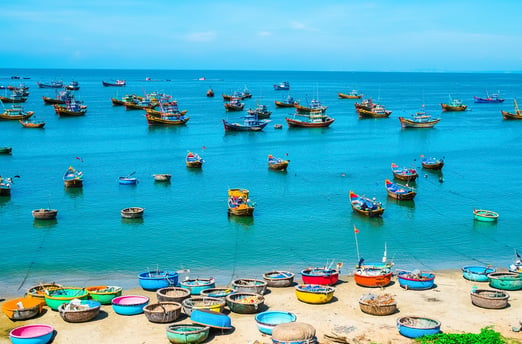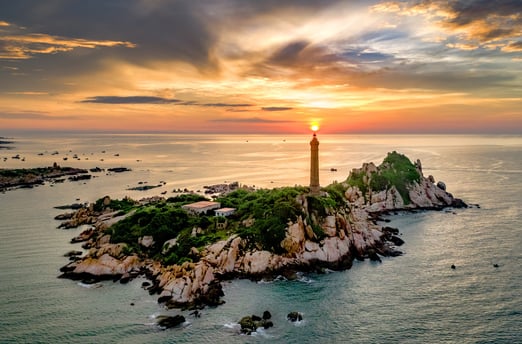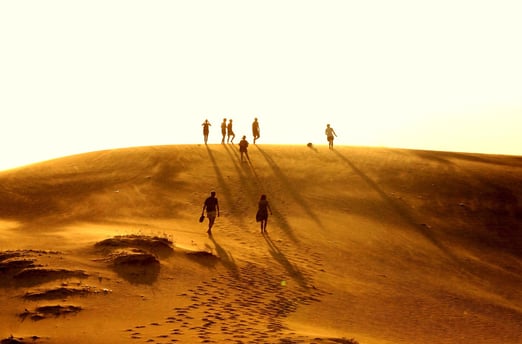Welcome to Addy Travel. Hotline: +84 983 585 189 - Email: info@addytravel.com
Mui Ne Travel Guide
Mũi Né is a coastal promontory in Phan Thiết, a renowned tourist hub in Bình Thuận Province. The name "Mũi Né" originates from local fishermen. "Mũi" means a land protrusion into the sea, while "Né" signifies a place to avoid storms. In 2018, Mũi Né was designated as a national tourist site, famous for its long stretches of pristine beaches and beautiful sand dunes
TRAVEL GUIDE
12/26/20242 min read


Best Time to Visit Mũi Né
Mũi Né welcomes visitors year-round, with each season offering a unique charm. The best time to visit is from April to August when the sea is crystal-clear and refreshing. From August to December, Mũi Né attracts surf and extreme sports enthusiasts. December may bring rain, so carrying an umbrella is advisable.
Getting There
Traveling to Mũi Né from Ho Chi Minh City (HCMC) is convenient by motorbike, bus, or train. Adventurous travelers often choose the coastal route via Cát Lái Ferry, Long Thành, Bà Rịa, Hồ Tràm, and Lộc An, covering around 230 km. Alternatively, buses from Eastern Bus Station take approximately 5 hours at 130,000 VND per ticket. Trains from Saigon Station cost around 110,000 VND, with morning departures.
From Hanoi, visitors can fly to HCMC or Cam Ranh, then take a bus to Mũi Né (around 200 km). Since April 29, 2023, the Dầu Giây – Phan Thiết expressway has shortened the drive from HCMC to just 2 hours. Phan Thiết Airport is expected to open by late 2023.
Top Attractions in Mũi Né
Hòn Rơm – A small, untouched mountain perfect for sunrise and sunset viewing, camping, and swimming.
Red Sand Dunes – Famous for their mesmerizing shifting colors and sand sledding activities.
Hòn Ghềnh (Hòn Lao) – Ideal for fishing, snorkeling, and sunset watching. Accessible by boat.
Bàu Trắng – Bàu Sen – Natural freshwater lakes amidst white sand dunes, resembling a mini-Sahara.
Suối Tiên – A picturesque stream with unique rock formations, nicknamed "Fairy Stream."
Mũi Né Fishing Village – A tranquil spot to observe local fishermen and buy fresh seafood in the morning.
Duc Thanh School – A historic school where President Hồ Chí Minh once taught.
Vạn Thủy Tú Temple – Home to Vietnam’s largest whale skeleton, central to local sea-worship rituals.
Mũi Né Bay – Renowned for its pristine beaches and secluded islands like Hòn Lao.
Poshanư Cham Towers – Ancient Cham architecture located 7 km from Phan Thiết city.
Local Food
Seafood Salad – Made from fresh fish or snail, served with herbs, noodles, and a special dipping sauce.
Lizard Dishes – A Mũi Né specialty, including grilled, stewed, and porridge lizard dishes.
King Crab (Cua Huỳnh Đế) – Best enjoyed steamed or grilled, particularly in the lunar New Year period.
Bánh Tráng Dẻo & Mắm Ruốc – Popular street snacks found at roadside stalls.
Lẩu Thả – A signature seafood hotpot dish featuring thinly sliced fish and vegetables, served with a tangy dipping sauce.
Accommodation
Mũi Né offers a wide range of accommodation, from budget homestays (around 500,000 VND per night) to upscale resorts. Mid-range hotels (700,000 to 1 million VND per night) are mainly located on Nguyễn Đình Chiểu Street.
Luxury resorts like The Anam, Anantara Mui Ne, and The Cliff Resort & Residences provide beachfront villas, spas, and private beaches.
Tips for Visitors
Seek calm beaches with safety signs for swimming.
Hòn Rơm hosts vibrant seafood night markets.
Mũi Né attracts many international visitors, particularly from Russia and South Korea. Some hotels rent bikes exclusively to foreign guests.




Connect with us
Experience authentic Vietnam with personalized travel journeys.
Contact us
Sign up for the best offer
Email: info@addytravel.com
Hotline: +84-983 585 189
© 2024. All rights reserved by Addy Travel
